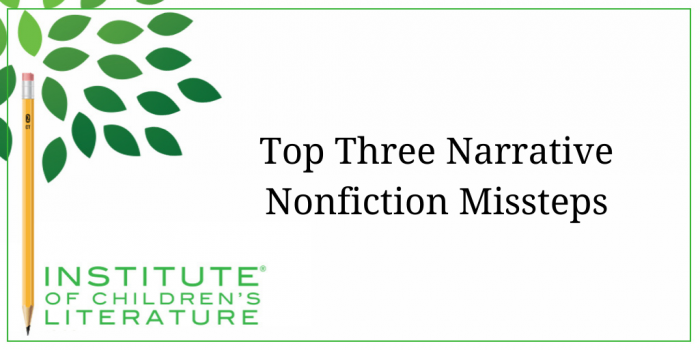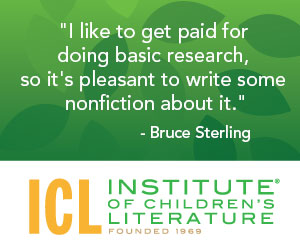1000 N. West Street #1200, Wilmington, DE 19801
© 2024 Direct Learning Systems, Inc. All rights reserved.

We teach our students how to write and get published!
View our Course Catalog >
Bad beginnings are probably the surest way to kill a sale of your manuscript because you can lose the reader so quickly with a bad beginning. So what makes a bad beginning in narrative nonfiction? Usually one of two things: an opening that confuses the reader or an opening that bores the reader. And it’s surprisingly easy to do one or the other.

Unfortunately, the moment a person is born is rarely of interest to anyone other than that person and his or her immediate family, so beginning your narrative nonfiction with the moment a person is born is rarely interesting (unless the person was born in the middle of the Chicago fire or while the family was fleeing a volcanic eruption. Births are momentous, but there are details you flatly cannot include in children’s nonfiction, and without them, births are rarely gripping storytelling, and therefore not a good opening.)
Because of this, many biographies begin at a pivotal, interesting moment in the subject’s life, then the author later fills-in the less interesting details or saved the really dull bits for a timeline at the end. And if the biography focuses on a single, fascinating incident, then it’s even easier to simply hold all the dull stuff for the timeline or author notes tucked in the back of the book.
Confusion is another bad beginning. This can happen when your narrative nonfiction requires a number of unfamiliar terms or some complicated technology or science. If you throw the reader into a biography of Einstein by trying to explain his views on time, the reader may discard the book as being too hard or too confusing. So beginning with the human element and then carefully adding the more technical elements with clear explanations (or even sidebars and infographics) can help the reader become caught up in the story enough to stay with you through the more complex thinking needed later.
Because narrative nonfiction is so reliant on reader interest, it can become really tempting to wander into fiction by imagining conversations or dipping into the subject’s thoughts. Though you may have some research back-up to make you confident he probably did think that thought, the only way to include something like detailed conversations or direct thoughts is if you uncovered research of exactly those things.
For instance, you find a letter in which your subject related a conversation to his wife or a journal entry where the subject wrote, “When the fire started, my first thought was ‘no school tomorrow!'” Those kinds of research discoveries are rare gems, so it can be tempting to simply create likely conversations or possible thoughts, and that’s when a book crosses from nonfiction to fiction.
So what is the problem with using fiction to bring nonfiction to life? There actually isn’t one, as long as the resulting book is labelled fiction or identified as “based on a true story.” There have been many excellent children’s book that use actual events as a springboard for fiction. Lois Lowry’s Number the Stars used fiction to bring Nazi occupied Denmark to life, and Linda Sue Park’s When My Name Was Keoko helped us better understand the Japanese occupation of Korea and what it was like for the Korean people. But though history colors every part of the story, each book is clearly historical fiction.
Some books have taken the use of history even one step further by turning real historical figures into characters in fiction. An excellent example of this is Jordan Stratford’s The Case of the Missing Moonstone which turn Lady Ada Byron (who grew up to be English mathematician Ada Lovelace) and Mary Godwin (better known as Mary Shelley, author of Frankenstein) into child detectives. Making it plain to the reader that the book in their hands is fiction keeps the reader from quoting the book in a report or leaning on it for research because it’s not nonfiction. We never want to present a reader, especially a young reader, with untrustworthy nonfiction.
Similar to the boring opening, a boring voice can make a reader abandon what could be a very successful narrative. Many of us think of nonfiction as being similar to the textbooks we encountered in school with their rather wordy, dull prose. But narrative nonfiction is storytelling and the writing needs to reflect that. That means the voice must be full of strong verbs, evocative nouns, and interesting figures of speech. In other words, it needs to be written with the same strength and attention to liveliness as fiction.
This also means that care must be taken when selecting which things to present in narrative and which things to give as direct quotes. For instance, if your narrative nonfiction is about a great scientific discovery and you can find piles of interviews given by the person who made the discovery, you’ll find yourself with an embarrassment of riches when it comes to choosing quotes. And we know readers love quotes because they remind us of dialogue. And we love dialogue. But not all quotes are created equal. You need something meaningful, and interesting, and easy to understand. A quote that is meaningful but full of jargon won’t work because young readers will find it confusing. A quote that is lively and easy to understand but not meaningful to the story you’re telling will be out of place. So finding the right quote can be painstaking but definitely worthy of care and time.
Since much of the research for your final narrative piece is likely to be from rather dry academic sources, it can be difficult to shake free of that voice when sitting down to write your book. But that stilted, wordy, dry voice will kill children’s nonfiction. So one good thing to try after you’ve gathered all your research and done all your reading is to take a short break and read lively children’s narrative nonfiction for a week. The books don’t need to be on your subject. They simply need to be interesting and engaging. Absorb the wonderful voices of the best children’s nonfiction writers, some of whom have been named in the eNews this month. Ask your children’s librarian for suggestions of others. The more books you read, the more your own lively voice, inspired by all that you’ve read, will come forth when you finally sit down and begin writing your narrative nonfiction.
With over 100 books in publication, Jan Fields writes both chapter books for children and mystery novels for adults. She’s also known for a variety of experiences teaching writing, from one session SCBWI events to lengthier Highlights Foundation workshops to these blog posts for the Institute of Children’s Literature. As a former ICL instructor, Jan enjoys equipping writers for success in whatever way she can.
1000 N. West Street #1200, Wilmington, DE 19801
© 2024 Direct Learning Systems, Inc. All rights reserved.
1000 N. West Street #1200, Wilmington, DE 19801
© 2024 Direct Learning Systems, Inc. All rights reserved.
1000 N. West Street #1200, Wilmington, DE 19801
© 2024 Direct Learning Systems, Inc. All rights reserved.
1000 N. West Street #1200, Wilmington, DE 19801
© 2024 Direct Learning Systems, Inc. All rights reserved.

1000 N. West Street #1200, Wilmington, DE 19801
© 2025 Direct Learning Systems, Inc. All rights reserved.

1000 N. West Street #1200, Wilmington, DE 19801
©2025 Direct Learning Systems, Inc. All rights reserved. Privacy Policy.
4 Comments